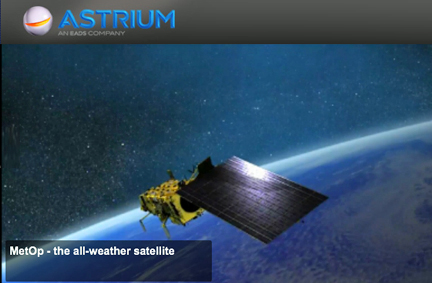
Artistic rendition of the MetOp satellite. MetOp is the next contribution to European weather satellite systems. A European Space Agency-Eumetsat joint project, MetOp is designed provide data for medium-term weather forecasts and long-term climate and environmental research. More information here...
The IASI-NG instruments will form part of the state-of-the-art instrumentation carried by the MetOp Second Generation (MetOp-SG) satellites, which constitute the space segment of the EUMETSAT Polar System Second Generation (EPS-SG). The prototype satellites are developed by the European Space Agency (ESA) and will be operated by EUMETSAT, Europe’s Meteorological Satellite Agency. The first generation EUMETSAT Polar System, which includes two Astrium-built MetOp satellites that are now in orbit, contributes some 40 per cent of the satellite data used in numerical weather prediction (NWP) models.
“In the middle of July ESA entrusted us with the design and manufacture of the MWS (MicroWave Sounder) instruments for MetOp-SG, and today the CNES has charged us with the task of developing and building a new instrument for this pioneering meteorological mission,” said Astrium Satellites CEO Eric Béranger. “Along with the high-performance instrument for the EUCLID mission and the contract, won in an international competition, for the supply of an ocean imager to the Korean Space Agency, the Astrium teams working on space instruments have now scored four successes in as many months. This is yet more proof that Astrium’s know-how and expertise are backed up by extremely solid results on the commercial front.”
IASI-NG data is obtained from measurements taken with the aid of a Fourier-transform spectrometer, which is the interferometer’s core. Its principal mission is to scan the various layers of the atmosphere, from the bottom to the top, in order to provide extremely accurate data on temperature and humidity. This information is used in real time by weather forecasters, who will draw on the high performance of IASI-NG instruments (which offer twice the spectral and radiometric accuracy of the previous generation) to significantly improve the quality and reliability of their forecasts.
IASI-NG will also provide data on the concentrations of different gases in the atmosphere, such as ozone and carbon monoxide. This data is extremely valuable to scientists in the chemical analysis of the atmosphere, and in tracking this data they can monitor air pollution, the state of the ozone layer and the global effect of greenhouse gases in real time. The main components of the IASI-NG instrument are as follows:
- A mirror-sweeping system, which, in conjunction with the satellite’s orbit, allows complete coverage of the Earth
- Two ultra-light silicon carbide (SiC) telescopes for transmitting optical beams
- An interferometer based on an innovative concept that is the subject of an Astrium/CNES patent and that simultaneously allows data to be acquired and parasitic effects to be compensated for with great accuracy
- A detection unit stored at a cryogenic temperature (of around -200°C), enabling coverage of the infrared band of 3.6 to 15.5 microns at an optimum signal-to-noise ratio
- An on-board real-time data processing system for pre-processing the huge amount of data acquired prior to its transmission to the ground

